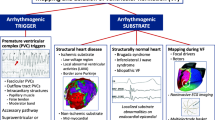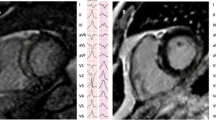Opinion Statement
Over the past decade, catheter ablation has emerged as an important therapeutic option for ventricular tachycardia (VT) in both patients with and without structural heart disease. In patients without structural heart disease, catheter ablation serves as sole therapy for the treatment of VT. For those with structural heart disease, VT ablation has generally been reserved for patients who experience ICD therapies, and particularly those who fail antiarrhythmic agents. With the growing number of patients with implantable devices as well as improvements in heart failure therapy resulting in improved survival among ICD patients, the overall number of patients needing therapy for VT continues to increase. The past years have witnessed significant advances in our understanding of the arrhythmic substrate in various cardiomyopathies, resulting in substrate-based approaches for targeted VT ablation. Further, the growth in better technologies and techniques for VT ablation, such as the use of percutaneous epicardial ablation, the innovation of multielectrode catheters for rapid mapping, the use of intracardiac echocardiography (ICE) for mapping unusual sites, and activation and entrainment mapping of previously unmappable VTs assisted by mechanical circulatory support devices, has overcome the limitations and greatly improved the success rates of catheter ablation. This review summarizes recent advances and novel approaches in both technology and techniques for catheter ablation of ventricular tachycardia.

Similar content being viewed by others
References and Recommended Reading
Papers of particular interest, published recently, have been highlighted as: • Of importance
John RM, Tedrow UB, Koplan BA, et al. Ventricular arrhythmias and sudden cardiac death. Lancet. 2012;380:1520–9.
Zipes DP, Camm AJ, Borggrefe M, et al. ACC/AHA/ESC 2006 Guidelines for Management of Patients With Ventricular Arrhythmias and the Prevention of Sudden Cardiac Death: A report of the American College of Cardiology/American Heart Association Task Force and the European Society of Cardiology Committee for Practice Guidelines (writing committee to develop Guidelines for Management of Patients With Ventricular Arrhythmias and the Prevention of Sudden Cardiac Death): developed in collaboration with the European Heart Rhythm Association and the Heart Rhythm Society. Circulation. 2006;114:e385–484.
Knackstedt C, Arndt M, Mischke K, et al. Depression, psychological distress, and quality of life in patients with cardioverter defibrillator with or without cardiac resynchronization therapy. Heart Vessels. 2013.
Borne RT, Varosy PD, Masoudi FA. Implantable cardioverter-defibrillator shocks: epidemiology, outcomes, and therapeutic approaches. JAMA Intern Med. 2013;173:859–65.
Czosek RJ, Bonney WJ, Cassedy A, et al. Impact of cardiac devices on the quality of life in pediatric patients. Circ Arrhythm Electrophysiol. 2012;5:1064–72.
Connolly SJ, Dorian P, Roberts RS, et al. Optimal Pharmacological Therapy in Cardioverter Defibrillator Patients (OPTIC) Investigators: Comparison of beta-blockers, amiodarone plus beta-blockers, or sotalol for prevention of shocks from implantable cardioverter defibrillators: the OPTIC Study: A randomized trial. JAMA. 2006;295:165–71.
Das MK, Zipes DP. Antiarrhythmic and nonantiarrhythmic drugs for sudden cardiac death prevention. J Cardiovasc Pharmacol. 2010;55:438–49.
Aliot EM, Stevenson WG, Almendral-Garrote JM, et al. EHRA/HRS expert consensus on catheter ablation of ventricular arrhythmias. Heart Rhythm. 2009;6:886–933.
Kuck KH, Schaumann A, Eckardt L, et al. VTACH study group: Catheter ablation of stable ventricular tachycardia before defibrillator implantation in patients with coronary heart disease (VTACH): A multicenter randomised controlled trial. Lancet. 2010;375:31–40. First multicenter randomized clinical trial suggests that ablation be considered early, in selected patients who are receiving an implantable cardioverter defibrillator for stable ventricular tachycardia.
Natale A, Raviele A, Al-Ahmad A, et al. Venice Chart International Consensus document on ventricular tachycardia/ventricular fibrillation ablation. J Cardiovasc Electrophysiol. 2010;21:339–79.
Frankel DS, Mountantonakis SE, Robinson MR, et al. Ventricular tachycardia ablation remains treatment of last resort in structural heart disease: argument for earlier intervention. J Cardiovasc Electrophysiol. 2011;22:1123–8.
Izquierdo M, Ruiz-Granell R, Ferrero A, et al. Ablation or conservative management of electrical storm due to monomorphic ventricular tachycardia: differences in outcome. Europace. 2012;14:1734–9.
Di Biase L, Santangeli P, Burkhardt DJ, et al. Endo-epicardial homogenization of the scar versus limited substrate ablation for the treatment of electrical storms in patients with ischemic cardiomyopathy. J Am Coll Cardiol. 2012;60:132–41.
Delacrétaz E, Brenner R, Schaumann A, et al. VTACH Study Group. Catheter ablation of stable ventricular tachycardia before defibrillator implantation in patients with coronary heart disease (VTACH): an on-treatment analysis. J Cardiovasc Electrophysiol. 2013;24:525–9.
Pauriah M, Cismaru G, Magnin-Poull I, et al. A stepwise approach to the management of postinfarct ventricular tachycardia using catheter ablation as the first-line treatment: a single-center experience. Circ Arrhythm Electrophysiol. 2013;6:351–6.
Tung R, Boyle NE, Shivkumar K. Catheter ablation of Ventricular tachycardia. Circulation. 2010;122:e389–91.
Robinson MR, Hutchinson MD. Use of imaging techniques to guide catheter ablation procedures. Curr Cardiol Rep. 2010;12:374–81.
Tung R, Shivkumar K. The value of image integration for epicardial catheter ablation of ventricular tachycardia. JACC Cardiovasc Imaging. 2013;6:53–5.
Fernández-Armenta J, Berruezo A, Andreu D, et al. Three-dimensional architecture of scar and conducting channels based on high resolution ce-CMR: insights for ventricular tachycardia ablation. Circ Arrhythm Electrophysiol. 2013;6:528–37.
Ashikaga H, Arevalo H, Vadakkumpadan F, et al. Feasibility of image-based simulation to estimate ablation target in human ventricular arrhythmia. Heart Rhythm. 2013;10:1109–16.
Tian J, Jeudy J, Smith MF, et al. Three-dimensional contrast-enhanced multidetector CT for anatomic, dynamic, and perfusion characterization of abnormal myocardium to guide ventricular tachycardia ablations. Circ Arrhythm Electrophysiol. 2010;3:496–504.
Komatsu Y, Cochet H, Jadidi A, et al. Regional myocardial wall thinning at multidetector computed tomography correlates to arrhythmogenic substrate in postinfarction ventricular tachycardia: assessment of structural and electrical substrate. Circ Arrhythm Electrophysiol. 2013;6:342–50.
Tandri H, Calkins H. MR and CT imaging of arrhythmogenic cardiomyopathy. Card Electrophysiol Clin. 2011;3:269–80.
Yang Y, Connelly KA, Zeidan-Shwiri T, et al. Multi-contrast late enhancement CMR determined gray zone and papillary muscle involvement predict appropriate ICD therapy in patients with ischemic heart disease. J Cardiovasc Magn Reson. 2013;15:57.
Tung R, Josephson ME, Reddy V, et al. SMASH-VT Investigators. Influence of clinical and procedural predictors on ventricular tachycardia ablation outcomes: an analysis from the substrate mapping and ablation in sinus rhythm to halt ventricular tachycardia trial (SMASH-VT). J Cardiovasc Electrophysiol. 2010;21:799–803.
Marchlinski FE, Callans DJ, Gottlieb CD, et al. Linear ablation lesions for control of unmappable ventricular tachycardia in patients with ischemic and nonischemic cardiomyopathy. Circulation. 2000;101:1288–96. Important study of endocardial substrate mapping unmappable ventricular tachycardia in patients with ischemic and nonischemic cardiomyopathy.
Vergara P, Trevisi N, Ricco A, et al. Late potentials abolition as an additional technique for reduction of arrhythmia recurrence in scar related ventricular tachycardia ablation. J Cardiovasc Electrophysiol. 2012;23:621–7.
Nakahara S, Tung R, Ramirez RJ, et al. Distribution of late potentials within infarct scars assessed by ultra-high-density mapping. Heart Rhythm. 2010;7:1817–24.
Nakahara S, Tung R, Ramirez RJ, et al. Characterization of the arrhythmogenic substrate in ischemic and nonischemic cardiomyopathy implications for catheter ablation of hemodynamically unstable ventricular tachycardia. J Am Coll Cardiol. 2010;55:2355–65.
Jaïs P, Maury P, Khairy P, et al. Elimination of local abnormal ventricular activities: a new end point for substrate modification in patients with scar-related ventricular tachycardia. Circulation. 2012;125:2184–96.
Tung R, Nakahara S, Maccabelli G, et al. Ultra high-density multipolar mapping with double ventricular access: a novel technique for ablation of ventricular tachycardia. J Cardiovasc Electrophysiol. 2011;22:49–56.
Della Bella P, Bisceglia C, Tung R. Multielectrode contact mapping to assess scar modification in post-myocardial infarction ventricular tachycardia patients. Europace. 2012;14 Suppl 2:ii7–12.
Sacher F, Roberts-Thomson K, Maury P, et al. Epicardial ventricular tachycardia ablation a multicenter safety study. J Am Coll Cardiol. 2010;55:2366–72. An important multicenter clinical trial that described the safety of epicardial ventricular tachycardia ablation.
Polin GM, Haqqani H, Tzou W, et al. Endocardial unipolar voltage mapping to identify epicardial substrate in arrhythmogenic right ventricular cardiomyopathy/dysplasia. Heart Rhythm. 2011;8:76–83.
Hutchinson MD, Gerstenfeld EP, Desjardins B, et al. Endocardial unipolar voltage mapping to detect epicardial ventricular tachycardia substrate in patients with nonischemic left ventricular cardiomyopathy. Circ Arrhythm Electrophysiol. 2011;4:49–55. This study described the role of endocardial unipolar voltage mapping to predict an epicardial substrate in NICM patients.
Piers SR, van Huls van Taxis CF, Tao Q, et al. Epicardial substrate mapping for ventricular tachycardia ablation in patients with non-ischaemic cardiomyopathy: a new algorithm to differentiate between scar and viable myocardium developed by simultaneous integration of computed tomography and contrast-enhanced magnetic resonance imaging. Eur Heart J. 2013;34:586–96.
Berruezo A, Fernández-Armenta J, Mont L, et al. Combined endocardial and epicardial catheter ablation in arrhythmogenic right ventricular dysplasia incorporating scar dechanneling technique. Circ Arrhythm Electrophysiol. 2012;5:111–21.
Dukkipati SR, d'Avila A, Soejima K, et al. Long-term outcomes of combined epicardial and endocardial ablation of monomorphic ventricular tachycardia related to hypertrophic cardiomyopathy. Circ Arrhythm Electrophysiol. 2011;4:185–94.
Koruth JS, Aryana A, Dukkipati SR, et al. Unusual complications of percutaneous epicardial access and epicardial mapping and ablation of cardiac arrhythmias. Circ Arrhythm Electrophysiol. 2011;4:882–8.
Della Bella P, Brugada J, Zeppenfeld K, et al. Epicardial ablation for ventricular tachycardia: a European multicenter study. Circ Arrhythm Electrophysiol. 2011;4:653–9. A European multicenter study described the epicardial percutaneous ablation in 6 European high-volume ventricular tachycardia ablation centers.
Bai R, Di Biase L, Shivkumar K, et al. Ablation of ventricular arrhythmias in arrhythmogenic right ventricular dysplasia/cardiomyopathy: arrhythmia-free survival after endo-epicardial substrate based mapping and ablation. Circ Arrhythm Electrophysiol. 2011;4:478–85.
Tung R, Michowitz Y, Yu R, et al. Epicardial ablation of ventricular tachycardia: an institutional experience of safety and efficacy. Heart Rhythm. 2013;10:490–8.
Irie T, Kaneko Y, Nakahara T, et al. Three-dimensional electroanatomical mapping-guided catheter ablation of ventricular tachycardia originating in the left anterior papillary muscle. J Cardiovasc Electrophysiol. 2010;21:214–5.
Valdigem BP, Pereira FB, da Silva NJ, et al. Ablation of ventricular tachycardia in chronic chagasic cardiomyopathy with giant basal aneurysm: CartoSound, CT, and MRI merge. Circ Arrhythm Electrophysiol. 2011;4:112–4.
Ruisi CP, Brysiewicz N, et al. Use of intracardiac echocardiography during atrial fibrillation ablation. Pacing Clin Electrophysiol. 2013;36:781–8.
Yamada T, Doppalapudi H, McElderry HT, et al. Electrocardiographic and electrophysiological characteristics in idiopathic ventricular arrhythmias originating from the papillary muscles in the left ventricle: relevance for catheter ablation. Circ Arrhythm Electrophysiol. 2010;3:324–31.
Bunch TJ, Weiss JP, Crandall BG, et al. Image integration using intracardiac ultrasound and 3D reconstruction for scar mapping and ablation of ventricular tachycardia. J Cardiovasc Electrophysiol. 2010;21:678–84.
Bala R, Ren JF, Hutchinson MD, et al. Assessing epicardial substrate using intracardiac echocardiography during VT ablation. Circ Arrhythm Electrophysiol. 2011;4:667–743.
Bunch TJ, Mahapatra S, Madhu Reddy Y, et al. The role of percutaneous left ventricular assist devices during ventricular tachycardia ablation. Europace. 2012;14 Suppl 2:ii26–32.
Miller MA, Dukkipati SR, Mittnacht AJ, et al. Activation and entrainment mapping of hemodynamically unstable ventricular tachycardia using a percutaneous left ventricular assist device. J Am Coll Cardiol. 2011;58:1363–71.
Bunch TJ, Darby A, May HT, et al. Efficacy and safety of ventricular tachycardia ablation with mechanical circulatory support compared with substrate-based ablation techniques. Europace. 2012;14:709–14. This study described the role of intracardiac ultrasound in the substrate-guided ventricular tachycardia ablation.
Lü F, Eckman PM, Liao KK, et al. Catheter ablation of hemodynamically unstable ventricular tachycardia with mechanical circulatory support. Int J Cardiol. 2013. doi:10.1016/j.ijcard.2013.06.035.
Tokuda M, Sobieszczyk P, Eisenhauer AC, et al. Transcoronary ethanol ablation for recurrent ventricular tachycardia after failed catheter ablation: an update. Circ Arrhythm Electrophysiol. 2011;4:889–96.
Tholakanahalli VN, Bertog S, Roukoz H, et al. Catheter ablation of ventricular tachycardia using intracoronary wire mapping and coil embolization: description of a new technique. Heart Rhythm. 2013;10:292–6.
Compliance with Ethics Guidelines
Conflict of Interest
Dr. Zhiyu Ling and Dr. Adithya Hari each declare no potential conflict of interest relevant to this article.
Dr. Harikrishna Tandri received a grant from NIH.
Human and Animal Rights and Informed Consent
This article does not contain any studies with human or animal subjects performed by any of the authors.
Author information
Authors and Affiliations
Corresponding author
Additional information
This article is part of the Topical Collection on Arrhythmia
Rights and permissions
About this article
Cite this article
Ling, Z., Hari, A. & Tandri, H. VT ablation: New Developments and Approaches. Curr Treat Options Cardio Med 16, 297 (2014). https://doi.org/10.1007/s11936-014-0297-2
Published:
DOI: https://doi.org/10.1007/s11936-014-0297-2




